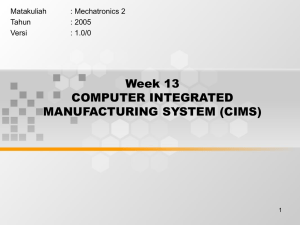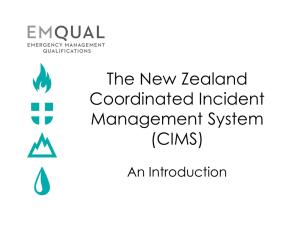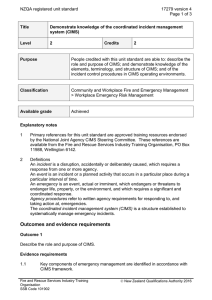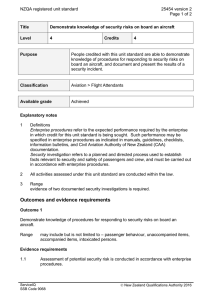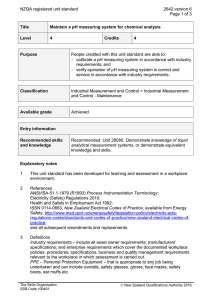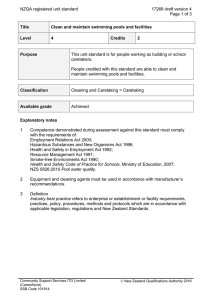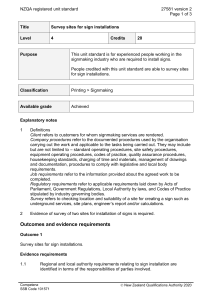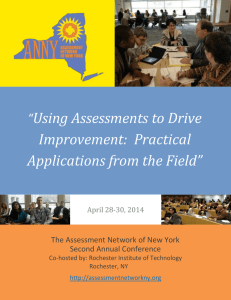CIMS - NZQA
advertisement
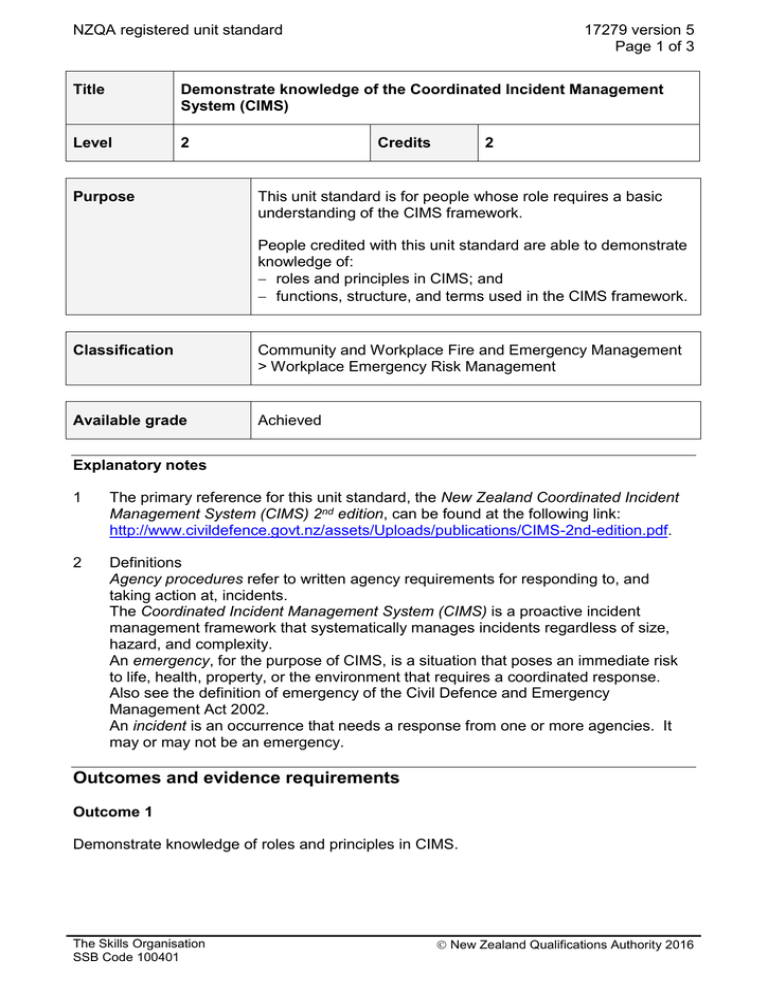
NZQA registered unit standard 17279 version 5 Page 1 of 3 Title Demonstrate knowledge of the Coordinated Incident Management System (CIMS) Level 2 Purpose Credits 2 This unit standard is for people whose role requires a basic understanding of the CIMS framework. People credited with this unit standard are able to demonstrate knowledge of: roles and principles in CIMS; and functions, structure, and terms used in the CIMS framework. Classification Community and Workplace Fire and Emergency Management > Workplace Emergency Risk Management Available grade Achieved Explanatory notes 1 The primary reference for this unit standard, the New Zealand Coordinated Incident Management System (CIMS) 2nd edition, can be found at the following link: http://www.civildefence.govt.nz/assets/Uploads/publications/CIMS-2nd-edition.pdf. 2 Definitions Agency procedures refer to written agency requirements for responding to, and taking action at, incidents. The Coordinated Incident Management System (CIMS) is a proactive incident management framework that systematically manages incidents regardless of size, hazard, and complexity. An emergency, for the purpose of CIMS, is a situation that poses an immediate risk to life, health, property, or the environment that requires a coordinated response. Also see the definition of emergency of the Civil Defence and Emergency Management Act 2002. An incident is an occurrence that needs a response from one or more agencies. It may or may not be an emergency. Outcomes and evidence requirements Outcome 1 Demonstrate knowledge of roles and principles in CIMS. The Skills Organisation SSB Code 100401 New Zealand Qualifications Authority 2016 NZQA registered unit standard 17279 version 5 Page 2 of 3 Evidence requirements 1.1 Identify key components of emergency management in accordance with the primary reference. 1.2 Identify agency roles in terms of CIMS structure. Range 1.3 own agency and any four agencies from – central and local government, emergency services, health services, other. Identify incidents where CIMS is used, in accordance with the primary reference. Range emergency, non-emergency. 1.4 Explain the principles of CIMS in accordance with the primary reference. 1.5 Explain how the principle of scalability relates to response level in accordance with the primary reference. Outcome 2 Demonstrate knowledge of functions, structure, and terms used in the CIMS framework. Evidence requirements 2.1 Explain the functions of CIMs in accordance with the primary reference. Range incident management team, governance. 2.2 Explain Coordination, Command, and Control in CIMS in accordance with the primary reference. 2.3 Explain lead agency, unified control, and support agency in relation to Coordination, Command, and Control in accordance with the primary reference. 2.4 Use CIMS incident control structure to identify functions and sub-functions in accordance with the primary reference. Range 2.5 two sub-functions for each of two functions. Define common terms in application of CIMS in accordance with the primary reference. Range The Skills Organisation SSB Code 100401 may include but is not limited to – assembly area, casualty clearing point, emergency operations centre, execution, incident control point, action plan, inner cordon, outer cordon, safe forward point, situation report, staging area, resources, Emergency Coordination Centre, National Coordination Centre, National Crisis Management Centre. New Zealand Qualifications Authority 2016 NZQA registered unit standard Planned review date 17279 version 5 Page 3 of 3 31 December 2021 Status information and last date for assessment for superseded versions Process Version Date Last Date for Assessment Registration 1 28 January 2000 31 December 2012 Revision 2 22 March 2004 31 December 2012 Review 3 24 January 2006 31 December 2012 Rollover 4 18 February 2011 31 December 2019 Review 5 21 July 2016 N/A Consent and Moderation Requirements (CMR) reference 0039 This CMR can be accessed at http://www.nzqa.govt.nz/framework/search/index.do. Please note Providers must be granted consent to assess against standards (accredited) by NZQA, before they can report credits from assessment against unit standards or deliver courses of study leading to that assessment. Industry Training Organisations must be granted consent to assess against standards by NZQA before they can register credits from assessment against unit standards. Providers and Industry Training Organisations, which have been granted consent and which are assessing against unit standards must engage with the moderation system that applies to those standards. Requirements for consent to assess and an outline of the moderation system that applies to this standard are outlined in the Consent and Moderation Requirements (CMRs). The CMR also includes useful information about special requirements for organisations wishing to develop education and training programmes, such as minimum qualifications for tutors and assessors, and special resource requirements. Comments on this unit standard Please contact The Skills Organisation at reviewcomments@skills.org.nz if you wish to suggest changes to the content of this unit standard. The Skills Organisation SSB Code 100401 New Zealand Qualifications Authority 2016
